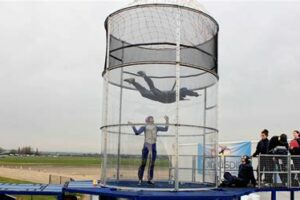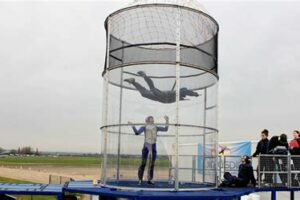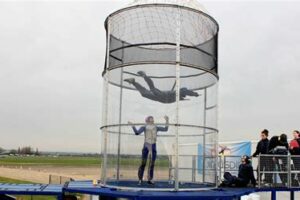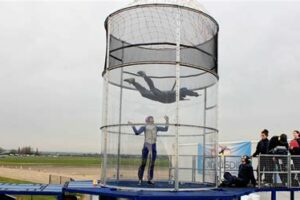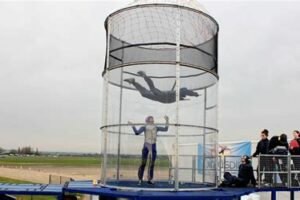Table of Contents
Indoor skydiving business cost varies depending on factors such as location, facility size, equipment quality, and staff training. Costs typically include construction, wind tunnel installation, safety measures, marketing, and employee wages. It is essential to carefully budget and plan to ensure a successful and profitable indoor skydiving business venture.
Are you looking to start your own indoor skydiving business but unsure about the costs involved? Well, look no further! In this article, we will provide you with a comprehensive breakdown of the expenses you can expect when setting up and running an indoor skydiving facility. From construction and equipment to staff training and marketing, we’ll guide you through each stage, giving you valuable insights and tips along the way. So, let’s dive right in and explore the fascinating world of indoor skydiving business costs!
Introduction
Welcome to this comprehensive guide on the cost of starting an indoor skydiving business. If you have ever dreamt of soaring through the air or wanted to provide a thrilling experience for others, indoor skydiving might be the perfect venture for you. However, before taking the leap, it is crucial to understand the various expenses involved in establishing and running such a business. In this article, we will provide you with an overview of the costs associated with starting an indoor skydiving business.
Market Research and Feasibility Study
Before diving into the financial aspects, it is essential to conduct thorough market research and feasibility studies. This step helps you understand the potential demand for indoor skydiving in your area and evaluate the competition. Hiring professionals to conduct market research can cost between $5,000 and $10,000, but it provides valuable insights that can help you make informed decisions.
Location and Real Estate
Finding the right location is crucial for an indoor skydiving business. You will need a building with sufficient height and space to accommodate the vertical wind tunnel. Purchasing or leasing such a property can range from $500,000 to $2 million, depending on the location and size. Additionally, you might incur costs for renovations, permits, and zoning approvals.
Equipment and Facility Setup
The heart of an indoor skydiving business lies in the wind tunnel and supporting equipment. The cost of a single wind tunnel can range from $3 million to $6 million, depending on its size and manufacturer. Additionally, you will need to invest in safety equipment, flight suits, helmets, and other facilities such as a viewing area, restrooms, and customer amenities. The total cost for equipment and facility setup typically exceeds $4 million.
Staffing and Training
An indoor skydiving business requires a team of skilled professionals, including instructors, technicians, managers, and support staff. Hiring and training these individuals can incur significant costs. The salaries for instructors and technicians can range from $40,000 to $80,000 per year, depending on their experience level and location. Additionally, you may need to invest in training programs and certifications for your staff.
Marketing and Advertising
To attract customers and create awareness about your indoor skydiving business, you will need to allocate a budget for marketing and advertising. This includes creating a website, developing promotional materials, online advertising, and local marketing campaigns. Depending on the scale of your marketing efforts, the cost can vary from a few thousand dollars to tens of thousands of dollars per year.
Insurance and Legal Costs
Running an indoor skydiving business involves inherent risks, and it is essential to have comprehensive insurance coverage. The cost of insurance will depend on factors such as the size of your business, the number of employees, and the coverage limits. Additionally, you may need to consult with legal experts to ensure compliance with safety regulations and liability protection, which can incur additional costs.
Operational Expenses
Operating an indoor skydiving business involves ongoing expenses such as rent or mortgage payments, utilities, maintenance, and repairs. These costs can vary significantly depending on the size of your facility and location. It is crucial to budget for these expenses to ensure smooth operations and customer satisfaction.
Contingency Funds
While planning your indoor skydiving business, it is essential to set aside a contingency fund for unexpected expenses. This can include unforeseen repairs, equipment maintenance, or any financial challenges that may arise during the initial stages of the business. Allocating around 10% of your total investment as a contingency fund is advisable.
Profitability and Return on Investment
Starting an indoor skydiving business can be a substantial financial commitment. It may take several years to achieve profitability and recoup your initial investment. Factors such as location, marketing efforts, competition, and customer demand will influence the timeline for profitability. Conducting a thorough financial analysis and creating a realistic business plan will help you estimate the time it takes to see a return on your investment.
Conclusion
Opening an indoor skydiving business can be an exhilarating and rewarding venture. However, it is crucial to consider the various costs involved in starting and running such a business. From market research and real estate to equipment and staffing, each aspect requires careful planning and budgeting. By understanding these costs and properly managing your finances, you can increase your chances of success in the thrilling world of indoor skydiving.
Indoor Skydiving Business Cost
Starting an indoor skydiving business can be an exciting venture, but it’s important to carefully consider the costs involved. From equipment and facility expenses to staffing and marketing, there are various factors to take into account. In this article, we will break down the different costs associated with establishing and running an indoor skydiving business.
Equipment Costs
The first major cost you will encounter when starting an indoor skydiving business is purchasing a vertical wind tunnel. The price of a wind tunnel can range from $1 million to $4 million, depending on the brand and specifications. Additionally, you will need to invest in high-quality skydiving gear such as helmets, goggles, jumpsuits, and safety equipment, which can amount to approximately $50,000. It is advisable to budget an estimated total of $1.5 million to $5 million for the initial investment in equipment.
Facility Costs
Securing a suitable facility for your indoor skydiving business is crucial. The cost of renting or purchasing a space will vary depending on factors such as location, size, and condition. Renting a space can range from $5,000 to $15,000 per month, while purchasing a building can cost between $500,000 and $2 million. Additional expenses may include renovations, maintenance, and utilities, estimated to be around $10,000 to $30,000 per month.
Instructor and Staff Costs
Hiring qualified skydiving instructors and staff members is essential for the success of your indoor skydiving business. The cost of instructors will depend on their experience and qualifications, generally ranging from $50,000 to $100,000 per year per instructor. Other staff members involved in customer service, administration, and maintenance can cost an additional $100,000 to $200,000 per year.
Marketing and Advertising Costs
To create awareness and attract customers, allocating a budget for marketing and advertising is essential. Costs may include the development of a website, social media campaigns, online and print advertisements, as well as partnerships with local businesses. Depending on the extent of your marketing efforts, expect to spend between $10,000 to $50,000 per year on promoting your indoor skydiving business.
Insurance and Liability Costs
As with any high-risk activity, obtaining comprehensive insurance coverage is critical for protecting your business and customers. Insurance costs for an indoor skydiving business can range from $20,000 to $50,000 per year, depending on the coverage limits and other factors. It is recommended to consult with insurance professionals specializing in extreme sports to ensure adequate coverage for your specific business needs.
Licensing and Permit Costs
Acquiring the necessary licenses and permits to operate an indoor skydiving business is a crucial step in the process. Costs associated with licensing and permits will vary based on the location and regulatory requirements of your specific area. It is advisable to consult with local authorities and industry experts to determine the estimated costs involved in obtaining the required licenses and permits.
Operational Costs
Operational expenses include the cost of electricity, heating, ventilation, and air conditioning (HVAC), as well as ongoing maintenance and repairs. Expect to allocate around $5,000 to $15,000 per month for these operational costs, depending on the size of your facility and the local utility rates. It is important to regularly maintain your equipment to ensure its optimal functionality and to minimize any potential downtime.
Miscellaneous Costs
Miscellaneous costs can include expenses such as software for managing bookings and customer records, as well as office supplies and uniforms for your staff. It is advisable to allocate an additional budget of approximately $5,000 to $10,000 per year for these miscellaneous expenses. Keeping track of these costs and regularly reviewing your budget will help you manage your indoor skydiving business efficiently.
In conclusion, starting and running an indoor skydiving business comes with various costs that need to be carefully considered. From equipment and facility expenses to staffing, marketing, insurance, and operational costs, it is important to budget and plan accordingly. Conducting thorough research and consulting with industry experts will help you establish a realistic estimate of the costs involved in launching and operating your indoor skydiving business.
Point of View:
-
Indoor skydiving business costs can vary depending on several factors:
- The location of the facility
- The size of the facility
- The quality and type of equipment used
- The level of training and expertise of the staff
- The marketing and advertising strategies employed
-
Initial set-up costs for an indoor skydiving business can range from $500,000 to $2 million or more.
-
The largest expense is typically the construction and outfitting of the wind tunnel itself. This can include the cost of acquiring land, building permits, construction materials, ventilation systems, and safety measures.
-
Equipment costs for an indoor skydiving business include the wind tunnel itself, flight suits, helmets, goggles, and other necessary gear for customers.
-
Ongoing operational costs include electricity, maintenance and repairs, insurance, staffing, and marketing expenses.
-
Staff training and expertise are crucial to ensure a safe and enjoyable experience for customers. Investing in well-trained instructors and coaches is essential.
-
Marketing and advertising are vital to attract customers to the indoor skydiving facility. This can include online and offline advertising, social media campaigns, partnerships with local businesses, and special events.
-
Offering different packages and pricing options can help cater to a wider range of customers and generate additional revenue.
-
Providing exceptional customer service and maintaining a high level of safety are key to building a strong reputation and ensuring repeat business.
-
Regularly reviewing and adjusting pricing strategies and cost structures can help maximize profitability and stay competitive in the market.
Voice and Tone:
The tone used in discussing the cost aspects of an indoor skydiving business should be informative and objective. The voice should convey a sense of expertise and professionalism, providing clear and concise information without being overly technical or intimidating. It should inspire confidence in potential investors or entrepreneurs considering entering the industry by highlighting the key factors and considerations involved in estimating and managing costs. The tone should also emphasize the importance of quality, safety, and customer satisfaction as essential components of a successful indoor skydiving business.
Thank you for visiting our blog to learn more about the cost of starting an indoor skydiving business. We understand that starting a new venture can be both exciting and daunting, especially when it comes to budgeting and finances. In this article, we have provided you with detailed information about the various costs involved in setting up and operating an indoor skydiving facility.
To begin with, it is important to note that the cost of starting an indoor skydiving business can vary depending on several factors such as location, size of the facility, equipment quality, and additional amenities. However, as a general estimate, you can expect to invest anywhere between $2 million to $5 million. This includes the construction or lease of a suitable building, installation of wind tunnel technology, purchasing necessary safety gear, marketing expenses, and staff salaries.
One of the major expenses when starting an indoor skydiving business is the wind tunnel itself. This state-of-the-art technology creates a controlled and safe environment for skydiving enthusiasts to experience the thrill of freefall. The cost of a wind tunnel can range from $1 million to $3 million, depending on its size, power, and brand. It is crucial to choose a reputable manufacturer that offers reliable equipment and excellent customer support.
Another significant cost to consider is the construction or lease of a suitable building for your indoor skydiving facility. The size of the building will depend on the number of tunnels you plan to have and the space required for other amenities such as a reception area, viewing gallery, changing rooms, and training rooms. Building costs can vary significantly depending on location, materials used, and additional features. Alternatively, leasing a pre-existing building can be a more cost-effective option, although renovations may still be necessary to meet your specific requirements.
In conclusion, starting an indoor skydiving business requires a substantial investment, primarily due to the high cost of wind tunnel technology and the construction or lease of a suitable building. It is important to conduct thorough market research, create a detailed business plan, and secure sufficient funding before embarking on this venture. While the initial costs may seem daunting, the growing popularity of indoor skydiving and the potential for a high return on investment make it an exciting opportunity for entrepreneurs in the adventure sports industry.
We hope that this article has provided you with valuable insights into the cost considerations associated with starting an indoor skydiving business. Should you have any further questions or require additional information, please do not hesitate to reach out to us. Wishing you all the best in your entrepreneurial journey!
.
People Also Ask About Indoor Skydiving Business Cost:
- How much does it cost to start an indoor skydiving business?
Starting an indoor skydiving business can vary in cost depending on various factors. On average, the cost to start an indoor skydiving facility ranges from $2 million to $4 million. This includes the construction of the wind tunnel, equipment purchase, lease or purchase of the building, and initial marketing expenses. - What are the ongoing expenses for an indoor skydiving business?
Ongoing expenses for an indoor skydiving business include staffing costs, equipment maintenance, utilities (electricity for running the wind tunnel), rent or mortgage payments, insurance, marketing and advertising, and general operational expenses. These costs can vary depending on the size of the facility and the number of customers served. - What are the revenue sources for an indoor skydiving business?
Indoor skydiving businesses generate revenue primarily through customer bookings for flight experiences. This can include individual sessions, group packages, birthday parties, corporate events, and training programs. Additional revenue streams may come from selling merchandise, concessions, or offering photography and video services to capture the experience for customers. - How long does it take to recoup the investment in an indoor skydiving business?
The time it takes to recoup the investment in an indoor skydiving business can vary based on several factors such as location, marketing efforts, customer demand, and operational efficiency. On average, it can take around 3 to 5 years to start seeing significant returns on investment, but this timeline can be influenced by various market conditions and business strategies. - What are the risks associated with starting an indoor skydiving business?
Like any business venture, there are risks involved in starting an indoor skydiving business. Some potential risks include high initial investment costs, competition from other similar businesses, seasonality of demand, regulatory compliance, equipment malfunctions, and the need for continuous marketing efforts to attract and retain customers. It is crucial to conduct thorough market research and create a comprehensive business plan to mitigate these risks to the best extent possible.

